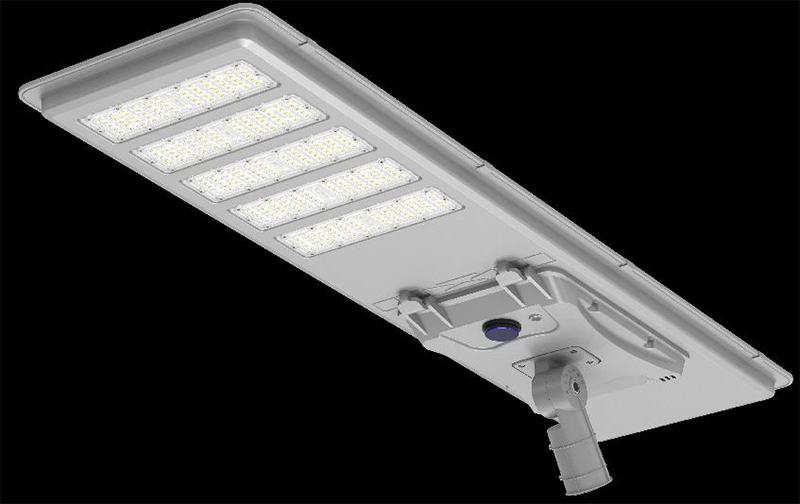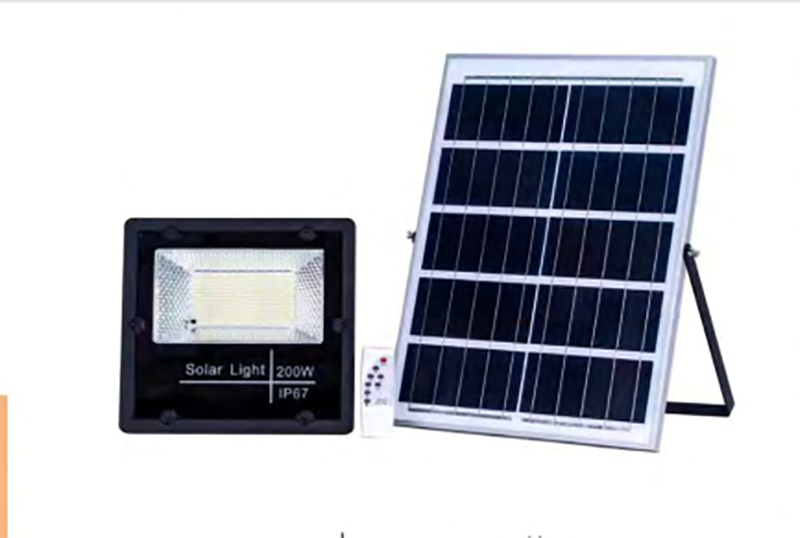A solar light is a lighting system that consists of LED lights, solar panels, batteries, a charge controller and can also have an inverter. The light runs on battery power and is charged through the use of solar photovoltaic panels.

Solar home lighting can replace other light sources, such as candles or kerosene lamps. Solar lamps are less expensive to run than kerosene lamps because, unlike fuel, the renewable energy of sunlight is free. Also, unlike kerosene lamps, solar lamps do not produce indoor air pollution. However, solar lights generally have a higher initial cost and are weather dependent.
Solar light
Components of Solar Lights Edit
solar panel
Most solar panels are made of single crystal silicon, a semiconductor material. Solar cells have two distinct layers of silicon. The lower layer has fewer electrons and therefore has a slightly positive charge due to the negatively charged nature of the electrons. Additionally, the upper layer has more electrons and has a slightly negative charge. A potential barrier is created between these two layers.

When streams of light particles called photons enter, they release energy to atoms in the silicon. It lifts an electron from a covalent bond to the next energy level from upper to lower. This promotion of electrons enables free movement within the crystal to generate an electric current. The more light passes through, the more electrons move around, and therefore, more current flows between them. This process is known as photovoltaics and the photoelectric effect. Photovoltaic systems convert sunlight directly into electricity.
Solar panels are made of layers of different materials in the order of glass, encapsulation, crystal cells, encapsulation, backplane, junction box and finally frame. Encapsulation prevents the ingress of moisture and contaminants, which can cause problems.
Battery
Batteries are usually housed inside metal or plastic casings. Inside the casing are the electrodes where chemical reactions take place, including the cathode and anode. There is also a separator between the cathode and anode that stops the electrodes from reacting together while allowing charge to flow freely between the two. Finally, the current collector conducts the charge from the battery to the outside.
In order to be able to operate in extreme temperature ranges, the cells inside solar lamps often use gel electrolyte technology with high performance in deep discharge. It can also use lead acid, nickel metal hydride, nickel cadmium or lithium.
This part of the light saves energy from the solar panels and provides power when needed at night when there is no light.
Often, the efficiency of photovoltaic energy conversion is limited due to physical reasons. About 24% of long wavelength solar radiation is not absorbed. 33% of the heat is lost to the surrounding environment and further losses are around 15-20%. Only 23% was absorbed, which means the battery is a critical part of the solar light.
Charge controller
This part controls the entire working system to protect battery power. It ensures that under any circumstances, including extreme weather conditions with large temperature differences, the battery will not be overcharged or overdischarged and will not further damage the battery.
This section also includes other components such as light controllers, time controllers, sound, temperature compensation, lighting protection, reverse polarity protection and AC transfer switches that ensure sensitive backup loads operate properly in the event of a power outage.
How Solar Lights WorkEdit
LED lamps are used because of their high luminous efficiency and long life. Under the control of the DC charge controller, the contactless control automatically turns the lights on in the dark and turns them off during the day. It is also sometimes used in conjunction with a time controller to set the shade time to automatically turn the lights on and off.
The chips include microchip®, B-, B+, S- and S+. Both S+ and S- are connected to the solar panel by wires, one is positively charged and the other is negatively charged. In this case, B- and B+ are connected to two batteries. When all of these are connected, this light will be displayed by the LED light.

Benefits of Solar Lights Edit
It makes it easier for customers to install and maintain solar lights since they don’t need cables. Solar lights can benefit homeowners by reducing maintenance and electricity costs. Solar lights can also be used in areas with no grid or remote areas that lack a reliable power supply. There are many stories of people suffering from lung disease, degenerated eyes, burns and sometimes even death simply because they don’t have a healthy alternative to lighting at night. After dark, the women felt unsafe walking to the toilets outside. Midwives deliver babies with only candles, and when the sun goes down, students cannot study due to illiteracy and poverty due to insufficient light. These are the realities of the world’s population of over a billion people. Lack of lighting equals persistent poverty around the world. In solar light, it converts light energy into electrical energy, i.e., it is convenient for our daily life.
Solar output is limited by the weather, if it is cloudy, wet or in winter, the efficiency of the solar energy may be reduced.
Homes that switch from kerosene lamps to solar lamps will also benefit from the health risks associated with kerosene emissions. Kerosene often has negative effects on the human lungs.
The use of solar energy links indoor kerosene to health problems, thereby reducing indoor pollution to the greatest extent possible. However, photovoltaic panels are made of silicon and other toxic metals, including lead, that can be difficult to dispose of.
The use of solar lights could improve education for homeschoolers without electricity. When non-profit organization Unite to Light donated solar lights to schools in the remote Kwa Zulu Natal region of South Africa, test scores and pass rates increased by more than 30 percent. Light gives students more time to study after dark.
A 2017 experimental study in a region without electricity in northern Bangladesh found that the use of solar lanterns reduced total household spending, increased children’s home study time and increased school attendance. However, it did not improve children’s educational achievement to a large extent.
Use of solar lights
Solar street light
These lights provide a convenient and cost-effective way to illuminate streets at night without the need for pedestrians and drivers to use the AC grid. They might have individual panels for each light of the system, or they might have a large central solar panel and battery pack to power multiple lights.
Rural
In rural India, solar lamps using LEDs or CFLs have been used to replace kerosene lamps, candles and other inexpensive lighting alternatives. Especially in areas where electricity is otherwise difficult to obtain, solar lights are very useful and it can also improve the quality of life.






